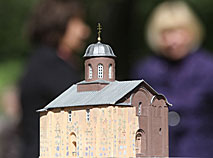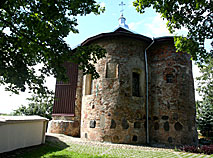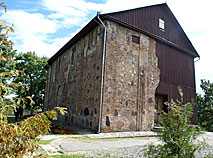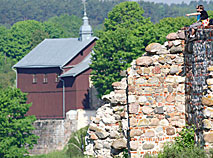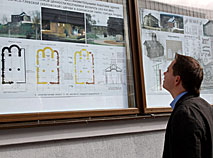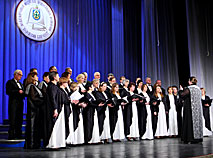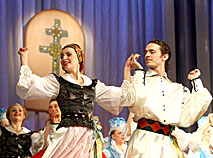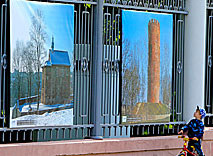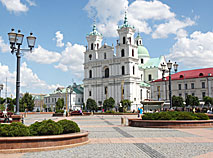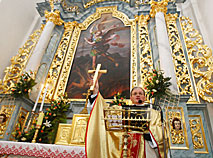Kolozha Church
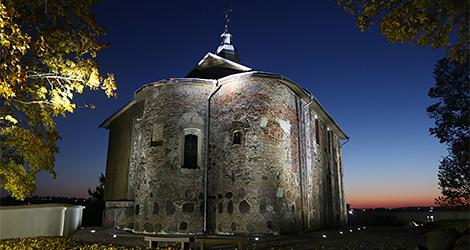
Sts Boris and Gleb Church (Kolozha Church) is an architectural pearl of ancient Grodno, a unique specimen of Eastern Orthodox architecture in Belarus and entire Eastern Europe.
Constructed in the northwestern part of Ancient Rus in the 12th century, the Kolozha Church is not like any other church in the world. This Christian halidom was nominated for the UNESCO World Heritage List.
History
It is unknown when the construction of the church began. It is believed that the church was erected on the steep bank of the Neman River in Grodno in 1140-1170. The church was founded by the sons of Grodno Prince Vsevolod and named in honor of the first Russian saints – Princes Boris and Gleb.
The church has another name – Kolozha Church and this name is more common now. The name “Kolozha” derives from the Kolozhan district in Grodno where the church was built. The word “kolozhan” meant a place overflowing with spring wells.
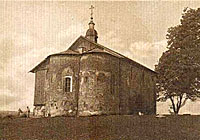 Others believe that the name Kolozha has to do with the resettlement of residents of the Kolozha fortress after the victorious campaign of Duke Vitaut to Pskov in 1409.
Others believe that the name Kolozha has to do with the resettlement of residents of the Kolozha fortress after the victorious campaign of Duke Vitaut to Pskov in 1409.
A devastating fire of 1184 destroyed the Lower Castle Church. Thus the Boris and Gleb Church became the main church of the town.
As a result of numerous Crusader attacks in the 14th century, the church fell into disrepair. To make it worse, the church was badly damaged by the troops of Ivan III during the wars with the Grand Duchy of Moscow.
The church was restored in the 16th century but it continued to suffer from natural disasters. The major threat to the church came from washaways and landslides.
On the night of 2 April 1853 the southern wall, part of the western wall and the ceiling of the church collapsed and slid into the river. The church remained neglected for the subsequent 40 years. The landslides of 1864 and 1889 inflicted even more damage to the church.
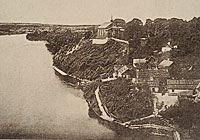 However, this unique church survived through thick and thin. In 1894-1906 the bank of the river was buttressed, light wooden walls were built in place of the wrecked stone walls and a cupola with a laced gold-plated cross was mounted on a new roof. This way the church survives to this very day.
However, this unique church survived through thick and thin. In 1894-1906 the bank of the river was buttressed, light wooden walls were built in place of the wrecked stone walls and a cupola with a laced gold-plated cross was mounted on a new roof. This way the church survives to this very day.
A renovation project was developed by the start of the 20th century, however it never came into fruition as the First World War broke out.
No church services were conducted in the Kolozha Church during the Soviet period. In 1948 the church was transferred to the history and archeology museum; in 1967 it made part of the Grodno History and Archeology Reserve together with the Castle Hill.
It was not until the early 1990s that the Kolozha Church was returned to the Belarusian Orthodox Church and reopened for church goers.
Architecture
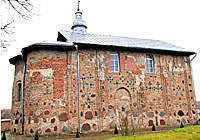 Sts. Boris and Gleb Church is a unique specimen of ancient stone architecture of the Grodno architectural school.
Sts. Boris and Gleb Church is a unique specimen of ancient stone architecture of the Grodno architectural school.
The church was designed following the traditions of the Byzantine temple architecture. Nevertheless, it has no direct analogues either in the Old Russian or in the Balkan architecture.
The Kolozha Church is a six-column triapsidal temple with additional space in the pre-altar part.
The Kolozha Church is unique due to the large number of ceramic vase-like indentations built into the walls. This architectural feature provides the temple with a wonderful acoustics.
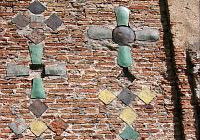 Besides, its bearing columns with circular cross-section are unusual for Orthodox temples. Thanks to these columns, the church seems spacious despite its small size (21.5m long and 13.5m wide). The 1.2m-wide walls made of thin flat brick (plinfa) also contribute to this impression.
Besides, its bearing columns with circular cross-section are unusual for Orthodox temples. Thanks to these columns, the church seems spacious despite its small size (21.5m long and 13.5m wide). The 1.2m-wide walls made of thin flat brick (plinfa) also contribute to this impression.
The Kolozha Church is also famous for its walls decorated with large polished stones and multicolor cross-shaped majolica tiles.
The interior of the Kolozha Church used to be decorated with unique wall paintings, fragments of which were found on the arch over the altar and the niches in the 1970s.
Kolozha Church Today
Today the Kolozha Church is one of the oldest functioning temples in Belarus. Apart from services and religious celebrations, the church also runs a Sunday school and a house church in honor of the icon of the Mother of God of Kolozha.
In the 1990s with participation of foreign specialists the riverbank was solidified to prevent landslides. The scientists also came up with several projects to restore the Kolozha Church to the way it looked in the 12th century and before the disaster of 1853.
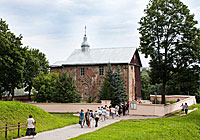 But the complicated geological structure and the lack of reliable information about the original design of the temple slowed down the pace of work. Later experts found some drawings of the western and southern walls of the Kolozha Church made one year before the collapse of the temple.
But the complicated geological structure and the lack of reliable information about the original design of the temple slowed down the pace of work. Later experts found some drawings of the western and southern walls of the Kolozha Church made one year before the collapse of the temple.
The reconstruction project of the pre-1853 Kolozha Church has been substantiated by architects. There are few documents about the 12th century sanctuary which looks changed many times over the decades. New information, however, can be included into the project.
In 2010 Belarus launched the Let Us Restore Kolozha Together campaign to raise funds for the restoration of the ancient landmark.
There are also plans to build a miniature replica of the 12th century Kolozha next to the church. Recreated with the help of the latest technologies and materials, it can become an interesting tourist site.
Wonderworking Kolozha Icon of the Mother of God
Since ancient times Sts. Boris and Gleb Church kept the Orthodox relic – the wonderworking Kolozha Icon of the Mother of God, a copy of Hodigitria Icon of Vilnius.
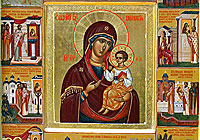 According to the legend, the image of the Holy Mother was willed to the church by a bagger who carried the wonderworking icon votively on his chest. They say that since the 17th century the icon has cured many people from different ailments.
According to the legend, the image of the Holy Mother was willed to the church by a bagger who carried the wonderworking icon votively on his chest. They say that since the 17th century the icon has cured many people from different ailments.
The icon was evacuated to Russia in 1915 and got lost there. Today the church keeps its replica while the search for the original image continues.
25 May is the day of the icon worship and dedication of the Church of the Kolozha Icon of the Mother of God. The day is celebrated with a liturgy and a prayer service.
Visiting Kolozha Church
The Kolozha Church is situated not far from the Old Castle of Grodno, which was the residence of Grand Duke Vitaut many centuries ago.
Address: 8 Kolozha Street
Interesting Facts
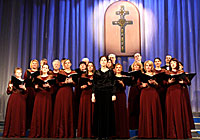 The Kolozha Church gave its name to one of the biggest international festivals of Orthodox singing in Belarus – Kolozhsky Blagovest, which gathers the best church and secular choirs in Grodno every February.
The Kolozha Church gave its name to one of the biggest international festivals of Orthodox singing in Belarus – Kolozhsky Blagovest, which gathers the best church and secular choirs in Grodno every February.
In May 2014 the Minsk Chelyuskintsev Park opened an open-air exhibition Belarusian Heritage, where one can see the image of Kolozha Church among the pictures of the architectural monuments of Belarus.
An unusual Nations Friendship Alley was laid in the Kolozha Park near the church during the 10th Festival of National Cultures. 35 rare trees, as many as the number of participants of the forum, were planted in the alley.
Landmarks near Kolozha Church
Grodno is one of the few Belarusian cities that have managed to preserve most of their old buildings. The mixture of different cultures and religions gives the city a special charm.
The center of Grodno is an architectural conservation area: the 300-hectare land plot features over 400 buildings of historical value.
Apart from the unique Kolozha Church, here one can see the Old and New Castles of Grodno dating back to the 16th and 18th centuries, palaces of noblemen, gorgeous Orthodox and Catholic churches and monasteries, and city blocks built at the end of the 19th – beginning of the 20th centuries.
The famous Grodno tourist attractions include:
-
Convent of the Nativity of the Mother of God
-
Cathedral of the Intercession of the Holy Virgin
-
St. Francis Xavier (Farny) Cathedral and the former Jesuit monastery
-
Church of the Discovery of the Holy Cross and the Bernardine monastery
-
Grodno Catholic Church and the Franciscan monastery
-
Church of the Annunciation and the Monastery of St. Brigitte
-
Gilibert Park (Jean Emmanuel Gilibert was head of the first medical academy in Grodno. The academy had a hospital and the largest botanical garden in Europe)
-
Puppet theater (the oldest theatrical stage in Belarus)
The Farny Cathedral boasts a high wooden altar with more than 20 figures of apostles and saints. One tower of the cathedral features the oldest European clockwork (it is even older than the Prague clock).
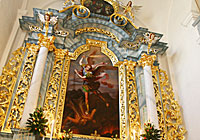 Near the Farny Cathedral one can find the Grodno Pharmacy Museum – the first European pharmacy in a separate building.
Near the Farny Cathedral one can find the Grodno Pharmacy Museum – the first European pharmacy in a separate building.
The Vitaut Fara was the largest church of Grodno built in 1389 by order of the Grand Duke. It survived several fires until 1961 when it was blown up. In 2014 a sculpture in the shape of a half-destroyed arc with a commemorative inscription was erected at the place of the former church.
Besides, at the place of the former Catholic Bernardine monastery (later Sts. Boris and Gleb monastery) of the 17th-20th centuries today there is an unusual sculpture Memorial Crosses in memory of the lost Grodno churches.


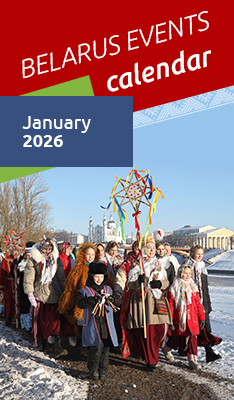




 print version
print version make home page
make home page add to bookmarks
add to bookmarks